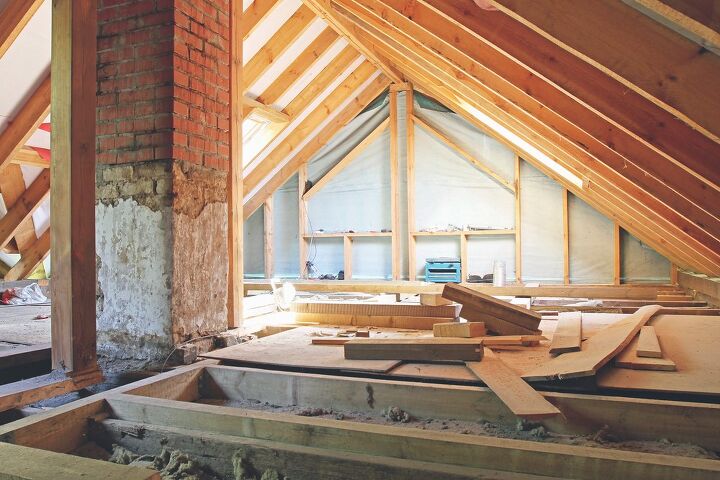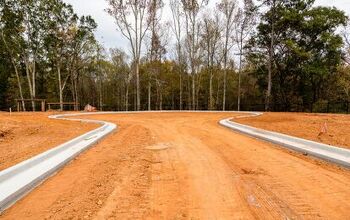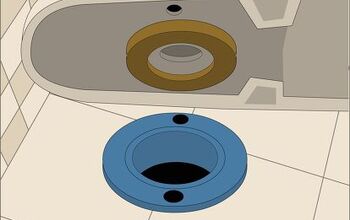6 Types of Attics (With Photos)

Attics are among the most divisive parts of a home and are useful in several ways depending on the type that you have. Some attics are exclusively ideal for storage whereas others are suitable to use as a living space. So, what are the types of attics and how are they different?
Truss attics, scuttle attics, vented, unvented, and garage attics are among the most common attic types. Scuttle attics have pull-down stairs are only for storage, and truss attics are unfinished and have structural trusses. Vented attics are energy efficient but can cause roof leaks, and unvented attics work as a living space.
You likely need to vent your attic if you have a high-pitched roof. Follow along as we explore the 6 types of attics and see how they differ.
1. Unfinished
Unfinished attics are possibly the most common type of attic. It is common to leave an attic unfinished if you only intend to use the space for storage. Homeowners spend an average of $40,000 to finish an attic, and it is understandable to put off that expense.
Unfinished attics are effective and great for storage, but they aren’t always ideal for energy efficiency or safety. Harmful particles and dust can hang in the air in unfinished attics, and that is one of their main downsides. It is not safe to use an unfinished attic as a living space, but you can safely store items if you are careful.
Unfinished attics do not count as square footage, and that can impact your resale value. Homeowners get an average 56% return on investment for a finished attic, but it can be much higher.
2. Truss
Truss attics are visually appealing, but they are difficult to finish and insulate. As the name suggests, there are exposed trusses in a truss attic, and they are unfinished. It is possible to finish a truss attic, but insulation doesn’t always take to the trusses well.
It is expensive to build a truss attic because attic trusses more than double a traditional truss. Truss attics are common above garages, but they aren’t exclusive to them. You cannot use a truss attic for a living space, but they are great for storage.
3. Finished
Finished attics have flooring, a ceiling, walls, and trim, and they add square footage to your home. The average finished attic is 7’ high ceilings and 7’ width. It is worth the average $40,000 it costs to finish an attic, and they have an average 60% return on investment.
A finished attic that is sealed and insulated can keep your energy bills down. It is possible to put too much insulation in your attic, so consult a professional when you finish the space. You can easily turn a finished attic into a bedroom or apartment for yourself or rent it out.
4. Scuttle
The classic scuttle attic is possibly the most common variety. Scuttle attics are easy to recognize because they have to pull down stairs and lack a permanent staircase. Homeowners generally use scuttle attics strictly for storage because they aren’t convenient to access and have limited space.
Scuttle attics are not comfortable or suitable to live in, and many homeowners don’t even use them for storage. Homeowners and repairmen often have to enter a scuttle attic for emergency repairs or routine maintenance. Avoid putting too many items or boxes in your scuttle attic to avoid ceiling collapses and make it easier to make repairs.
5. Texas Basement
A Texas basement is not a basement, but instead, it’s an attic that you can reach via a hallway or closet door. The name is a fun spin on the fact that basements are not common in Texas, but these unique attics certainly are. It is ideal to finish a Texas basement if you intend to use it for storage or as a living space.
Texas basements are often used as apartments or extra bedrooms. They can get stuffy just like any other attic, but Texas basements help regulate the temperature throughout a house when they’re sealed well. Despite the name, you can find homes with a “Texas basement” all over the country.
6. Garage
Garage attics are a gem for homeowners looking to add extra storage to their homes. You can finish an attic above your garage for an average of $14,300, and it’s worth it for the value that it adds. Homeowners also use garage attics as a living space, however, that is only ideal if you aren’t storing vehicles there.
Hobbyists and DIY homeowners can benefit from a garage attic and use it as a workspace. A well-sealed garage attic can help improve your home’s energy efficiency and regulate the temperature. Finish the attic above your garage so that you can increase your home’s square footage, and ultimately, resale value.
Vented vs. Unvented
Builder-owners have been torn between vented and unvented attics since attics have existed. The choice to vent your attic or leave it unvented isn’t as simple as it may seem. Let’s take a look at the difference between vented and unvented attics.
Vented
Vented attics are simply attics with vents in them. Builders insulate vented attics to prevent heat transfer, and that can improve your home’s energy efficiency. You can install gable vents, soffit vents, and a ridge vent to generate airflow and regulate the temperature in your attic.
Well-installed vents help regulate the temperature in hot and cold weather. It is smart to vent your attic if you plan to leave it unfinished to save on energy bills during the summer.
The main downside to vented attics is that they increase your risk of roof leaks. Vented attics are only energy efficient if you seal them well to avoid mold and moisture damage.
Unvented
Many homeowners leave their attics unvented and condition them instead. Conditioning an unvented attic makes it more suitable for storage, and they are energy efficient. You can use unvented attics as a living space or hold your HVAC system.
It takes a lot of spray foam insulation to insulate an unvented attic, but it is worth the cost. Unvented attics can be more energy-efficient than vented attics depending on how your home was built. Vented attics are ideal for high-pitched roofs, and unvented attics can accommodate more roof styles.
How To Make Attic More Efficient
Attics are only as useful as they are energy efficient, for better or worse. You can save a small fortune when your attic is well-sealed and has no leaking air. Some of the best ways to improve your attic’s energy efficiency include:
- Use a radiant barrier to help regulate the temperature in your attic and the rest of your home. You can either hang a radiant barrier from the ceiling to protect against extreme heat, or you can install it on the floor. Install a radiant barrier on your floor if you want to evenly distribute heat throughout other rooms in the house.
- Vent your attic to prevent ice damage and expensive roof repairs. Unvented attics can become damaged and allow air to leak out if ice forms in your gutters. Attic vents help reduce the workload of your HVAC system, and that can save on monthly energy bills.
- Install attic fans to protect your roof and keep your home’s temperature regulated. It costs an average of $600 to install an attic fan, and they can improve your energy efficiency. Make sure to properly insulate your attic or else the attic fan will be nearly useless.
- Identify and seal cracks or gaps in your attic. Cracks and gaps can allow hot or cold air in and lets the air in your attic escape. Your energy bills will generally be higher if you have existing cracks in your attic or roof.
Related Questions
Does the unfinished attic count as square footage?
No, an unfinished attic does not count as square footage, and they are not considered living spaces. You must add flooring, walls, trim, insulation, and a ceiling to finish your attic. Unfinished spaces such as cellars, basements, porches, and patios do not count as square footage either.
Should attics be vented?
Yes, you should vent your attic because it reduces heat and moisture on hot days. Attic vents can increase energy efficiency and reduce your electric bills during the summer. The only cons of attic vents are that they hum loudly and can cause allergy problems for some homeowners.
Are attics dangerous?
Unfinished attics can be dangerous if you don’t have strong flooring or if there are harmful particles in the air. Attics are susceptible to mold, and it can be dangerous if pests get stuck inside. Animal droppings and loose insulation or sawdust can make dangerous breathing conditions in an attic.
Do attic fans really work?
Yes, attic fans work to improve the airflow in your house and evenly circulate air. Attic fans can make the attic and the rest of the house more comfortable. They improve energy efficiency in both the summer and winter.
Summing It Up
Scuttle attics are among the most common and feature pull-down stairs. Attics that you can access with stairs are either finished, partially finished or unfinished. Unfinished attics don’t count as square footage because they aren’t livable spaces.
Truss attics are difficult to finish because of their layout, and it’s hard to insulate them. Garage attics are common additions, especially in new homes, but they are mostly suitable for storage. A Texas basement is a type of attic that you can access by a hallway or closet door.
Vented attics have ridge, gable, and soffit vents, and unvented attics can’t regulate temperature. Finish your attic to increase your home’s value and square footage.
Related Articles

Nick Durante is a professional writer with a primary focus on home improvement. When he is not writing about home improvement or taking on projects around the house, he likes to read and create art. He is always looking towards the newest trends in home improvement.
More by Nick Durante
































